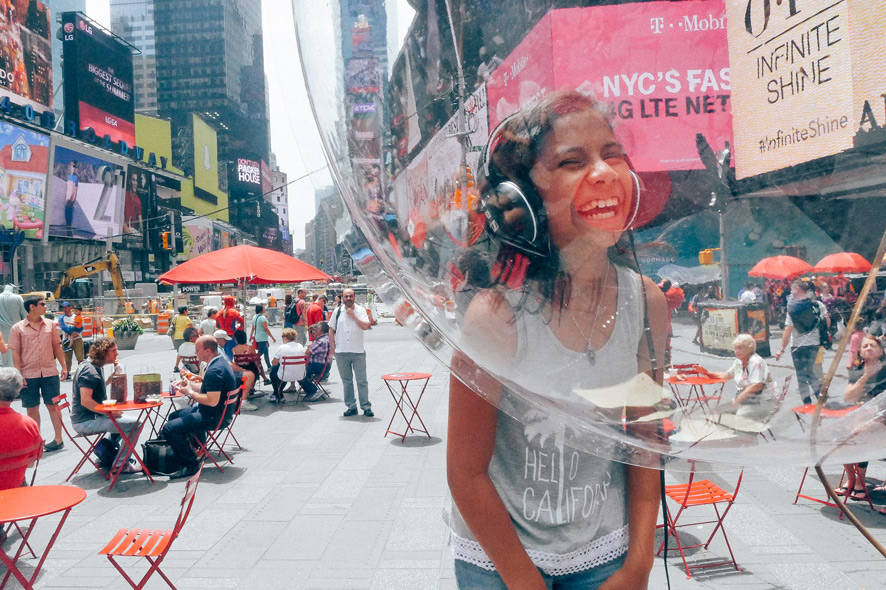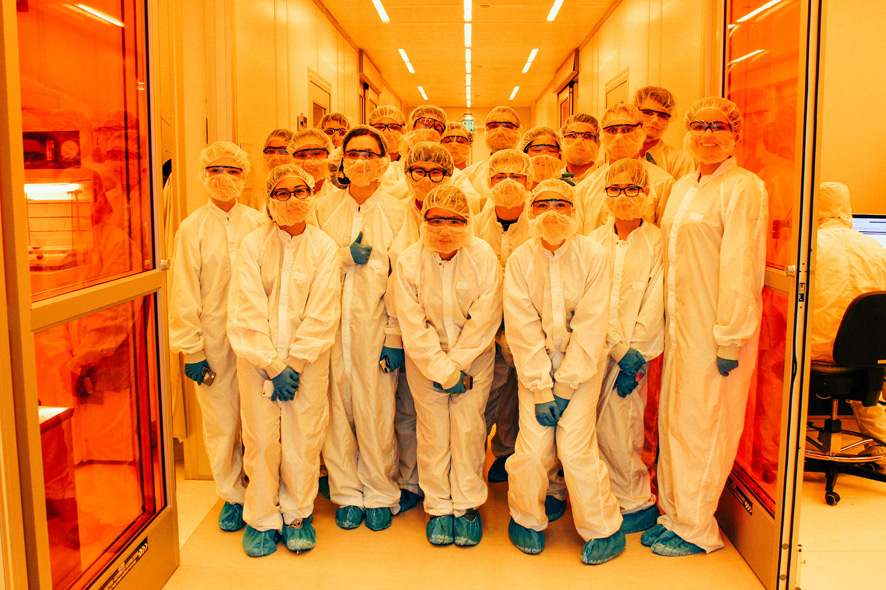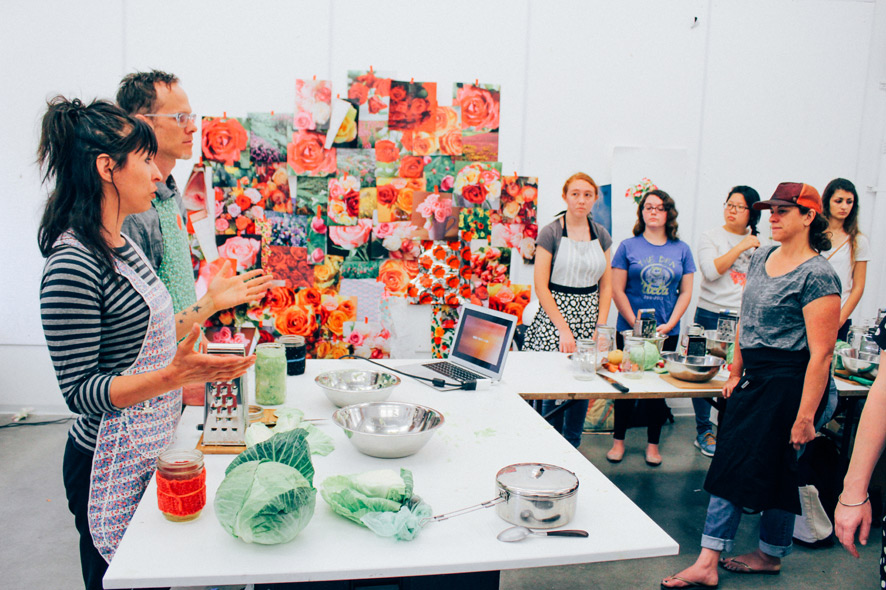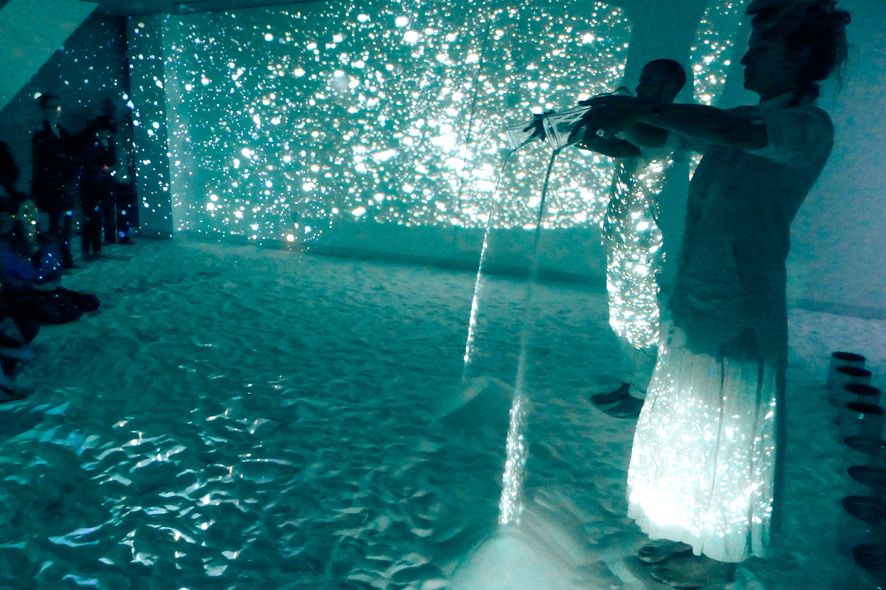A successful tradition is being carried on. Once again, Linz Art University’s Interface Cultures program has invited an international partner university to exhibit outstanding work being done on campus at the Ars Electronica Festival (September 7-11, 2017) in Linz. Victoria Vesna, artist and professor in the Department of Design|Media Arts at UCLA, told us how the school’s UCLA Art|Sci Center + Lab came to be and what intramural rifts had to be overcome for this to happen. Discussing her students and their interdisciplinary projects, Victoria Vesna marshals plenty of evidence demonstrating how art and science can clearly benefit from one another. In this interview, she also provides a foretaste of the theme of this year’s Campus Exhibition, “Feminist Climate Change.”
You are the founder and director of the UCLA Art|Sci Center. How did it happen that this institution was launched in 2005?
Victoria Vesna: In 2000, I was recruited from UCSB (UC Santa Barbara) to UCLA to chair and help rebuild the Design department. For the next five years, I worked tirelessly to put into place the Design | Media Arts – with the first effort being to add ‘Media Arts’ into the department name. One would imagine this a simple matter, but in academia, who owns the word media became a big political issue! After a year-long battle, we got the name change. I hired stellar faculty, worked on the curriculum, and things started to take off – the timing was perfect! At that time Media Arts was becoming established all over the world as a field. All of us who were setting up these programs were self taught – some may not realize that this is actually quite new in art education. In fact, some in the art world still do not accept media / interactive arts. Take the Venice Biennale for example. I love going there and even participated ages ago, but am amazed, year after year, at the lack of the inclusion of media arts!

Genesis by Naoko Tosa, Credit: UCLA
Anyway, this was a time of building not only the department but also the edifice itself – UCLA was in the midst of renovations after the disastrous Northridge earthquake. Being in a temporary space with everything in a state of flux was a great environment for creating something new and eventually, after five intense years the building was completed, people and curriculum were put in place and I felt that my work was done.
Although I negotiated my entrance into the position of the department chair quite well, I was not interested to continue on the administrative ladder. I learned how the system works and the limitations of it and did not want to perpetuate this but instead envision something new. So, I went to talk to the Dean at that time, Daniel Neuman, and he basically told me that I could not step down as a program review was about to happen and pretty much all faculty were too new to handle it. I did not know what to do, or how to react, as I felt really done. When he asked me “What would you like to do when after you step down?”, without hesitation, I said – “I would like to establish an Art and Science center and have spaces on both sides of campus, north and south.” He responded right away – “You got it. But, it will cost you another two years of chairing the department.”

The home of Art | Sci center + lab: The Broad Art Center in the North, the California NanoSystems Institute in the South, Credit: UCLA
When the Art | Sci center + lab iwas aunched in 2005, it did not get much understanding or support. I quickly understood that at the core was the Two Cultures problem. It was clear to me that we first had to address the divide between the North and South campus and shift the perception of this artificial separation—a leftover from the industrial age. So – the mission became building the Third Culture and I started walking back and forth locally between the North and South campus while having on my mind the global East / West connection and striving for diversity. It was not an easy or fun beginning to be honest – I encountered a lot of resistance and even some hostility. But I also discovered people on both sides who became and remain good friends – we like hanging out together regardless of our disciplinary training and this was the solid (human) foundation I was building on.

Bird Song Diamond at Times Square New York City, Credit: UCLA
The UCLA Art|Sci Center is all about the collaborations between arts and sciences. How do both sides benefit from each other? And what are they able to learn from each other?
Victoria Vesna: If you approach a problem from very different angles, perception changes and understanding grows within the process of discovery. The general idea is to jump into the unknown — genuine artists and scientists live for this. Exploring uncharted territories is such a rush. It is a life force and goes along with natural systems that strive to push forward. A good example is when I met nanoscientist James Gimzewski – he just arrived from IBM Zürich where he studies, among other things, the buckminsterfullerene molecules (buckyballs). In parallel, I studied Buckminster Fuller for my PhD with Roy Ascott, and through that found out about the discovery and naming of the molecule (1984). At first I was a bit intimidated and curious to learn more about the molecule and the STM (Scanning Tunneling Microscope). But, then he asked ‘who is Buckminster Fuller’ and, at that point, we started learning from each other and expanding our viewpoints. We collaborated with I as the artist, James as the scientist, with our first work being Zero @ Wavefunction.
In 2003-04, we worked together on a large exhibition at the LACMA museum – NANO. We had many students participate but I would like to point out two as an example of how both profit. Anne Niemetz, who was then a MFA student in Design Media Arts, working with me, and Andrew Pelling, who was a PhD student in Gimzewski’s lab. They were inspired by our collaboration and created their own great piece in the installation – Dark Side of the Cell and this was Anne’s MFA project – exhibited within our installation at the museum. To this day, they continue to work collaboratively and both are now Professors in New Zealand and Canada and are well recognized for their innovative, interdisciplinary work.

Credit: UCLA
In fact, we started really moving ahead full speed when a new generation of young scientists got attracted and started making major contributions to the shape and direction of the center—most notably, Siddharth Ramakrishnan (2006-09), Romie Littrell (2008-2012), Christina Agapakis (2012-24), Rita Blaik (2009-2015), Olivia Osborne (2015-present). Siddharth has a Ph.D. in neuroscience and was a Post Doc at UCLA, and now is the Jennie M. Caruthers Chair in Neuroscience at Puget Sound where he also encourages art & science collaborations. Romie was dissatisfied with the way the Ph.D. in Biotechnology was approached and he formed the LA DIY Bio group and was actively working in the center, helping with exhibitions for three years. After working as a project director and curator of Health and Biotech at the Museum of Innovation in San Francisco, he joined team Guerilla Science. Christina got her Ph.D. in Biology at Harvard and was also a Post Doc at UCLA when she came to the center. Now she is creative director at Ginko Bioworks. Rita has been working in parallel as a Ph.D. student in material science throughout her studies and was my teaching assistant for the Introduction to Art, Science & Technology three times, taught repeatedly in the NanoLab summer sessions, and actively participated in many events. Now she is the education coordinator at CNSI. All three had exhibitions in the Art Sci gallery and other public spaces nationally and internationally.

NanoLab, Credit: UCLA
What kind of facilities and opportunities do the students at the UCLA Art|Sci Center have?
Victoria Vesna: The Art|Sci gallery and labs at the California NanoSystems Institute (CNSI — South campus) and the Art|Sci Studio at the School of the Arts & Architecture (North campus) are both spaces that are on the 5th floor and relatively small, but it was important to have a presence and generate mixing of students, faculty, and staff. At we have access to some of the most cutting edge labs due to support from the former directors (Dr. Lenny Rome and Paul Weiss) and also the current director, Dr. Jeff Miller. Our students have access to cutting edge labs in nanotechnology, biochemistry, ecology and evolutionary biology, neuroscience and electrical engineering. We are connected to the Institute of Society and Genetics and are starting to work with the recently established LENS (Laboratory for Environmental Narrative Strategies). We have visiting artists and researchers who interact with the students involved in our program and organize many workshops and symposia. I always invite students to either participate directly or observe the process of creating complex collaborative projects I am involved in. The idea is to open the possibilities and allow students to design their own path using the amazing resources that UCLA has to offer.

NanoLab, Credit: UCLA
On what kind of issues are the students currently working on at the UCLA Art|Sci center?
Victoria Vesna: UCLA Art Sci is a research center established on a faculty’s expertise and not a teaching unit. The School of the Arts and Architecture hosts the department of Design Media Arts which is the teaching unit. Under the School and department we also have the Software studio led by Casey Reas, Game lab led by Eddo Stern and Scope lab led by Lauren McCarthy and Miriam Posner. Students are encouraged and invited to voluntarily participate in our activities and my classes benefit from the symposia, lectures and exhibitions that we host. Since the beginning of the center, I have been developing an online General Education (GE) class in parallel — Introduction to Art, Science & Technology that attracts students from every discipline you can imagine. Part of their class work is to attend not only events we host, but also to identify through experience all that is going on campus and Los Angeles that connects art and science. Now it is being offered to the entire UC system and it is great to have students share activities on their campuses related to the art science connection. I also teach an Honors class, Biotech & Art that is mostly attended by students from the sciences. One day – and it is not as easy as you may think – I will be able to create a class that formally connects these students. Unfortunately the out-dated educational systems still make this very difficult, but I am not giving up hope!

Credit: UCLA
My entire focus is to bring students together to exchange ideas and start collaborating before they get too entrenched in departmental separations. To this end, I even went further and developed a program for high school students who are interested in pursuing science but do not want to give up art or music. This year we are celebrating 10 years of the NanoLab and I calculated that about 600 students have entered academia, many in the sciences, without a binary view of two worlds. We are now doing a survey to see where they went after the experience and it is really inspiring to get their feedback! For instance, one former student is starting to work for Space-X and another is forming his own Nanoscience company in the Silcon Valley!
“Currently, students are exploring nanotech, biotech, neuro-science and there is a growing interest in the micro-biome – all in relation to the larger issues of the environment and the human condition.”

Foraging Workshop with Iain Kerr of SPURSE, Credit: UCLA
Last but not least: What are you going to show us at the Campus exhibition in September?
Victoria Vesna: For the campus exhibition, I decided it would be really important to address the local issue that Ars Electronica has been facing in relation to women exhibited and the global issue of climate change. To this end, I have recruited my research assistant Hsinyu Lin who is MFA alumni of the department of Design Media Arts and the co-founder of voidLab – a feminist collective for women. At the Art Sci center, our focus has been from the start on environmental issues and voidLab is focused on expanding the dialogue in feminist issues – we joined forces and invited a number Design Media Arts, voidLab and ArtSci alumni to participate. The title of the show is: FEMINIST CLIMATE CHANGE: Beyond the Binary
The goal is to present a different viewpoint and make a case that genuine Environmentalism is by default Feminism. In other words, if you truly care about your environment, no matter if you are male, female or in between – you will by default respectful of women. This explains why there are so many women in biology and it makes one wonder about physics and engineering – could it be that they are somehow disconnected from natural systems too much?
“Everything in nature is about BALANCE and DIVERSITY. In turn everything that is happening in our society and the environment is a direct reflection of our world being out of balance. When you have a group of men deciding what a woman’s right is in relation to her body, you know that chances are high that they would be equally inconsiderate of the Earth we all live in.”
I believe that we are in the midst of climate change on many levels and the title of the exhibition is deliberately provocative. The sciences clearly spelled out the danger of fossil fuels but is so deeply intertwined with the very system that supports this that dialogue becomes key – we will not survive in bubbles. We have to move away from the industrial age, separation of the sciences from the arts and humanities along with the reductionist methodologies that no longer work in an ever more complex world.
So, in addition to inviting MFA alumni from the Design Media Arts program, we have members of the voidLab, Game lab and Scope labs and some of the notable Art Sci alumni who represent the new generation scientists that are actively breaking this old pattern. I am super excited to about the show we are putting together and hope to engage artists, scientists, humanists and technologists and especially the public who will be participating in 2017 Ars Electronica Festival!

Victoria Vesna (US), Ph.D., is an Artist and Professor at the UCLA Department of Design | Media Arts and Director of the Art|Sci center at the School of the Arts and California Nanosystems Institute (CNSI). With her installations she investigates how communication technologies affect collective behavior and perceptions of identity shift in relation to scientific innovation (PhD, University of Wales, 2000). Her work involves long-term collaborations with composers, nano-scientists, neuroscientists, evolutionary biologists and she brings this experience to students. She is the North American editor of AI & Society and in 2007 published an edited volume – Database Aesthetics: Art in the Age of Information Overflow and another in 2011 – Context Providers: Conditions of Meaning in Media Arts.
